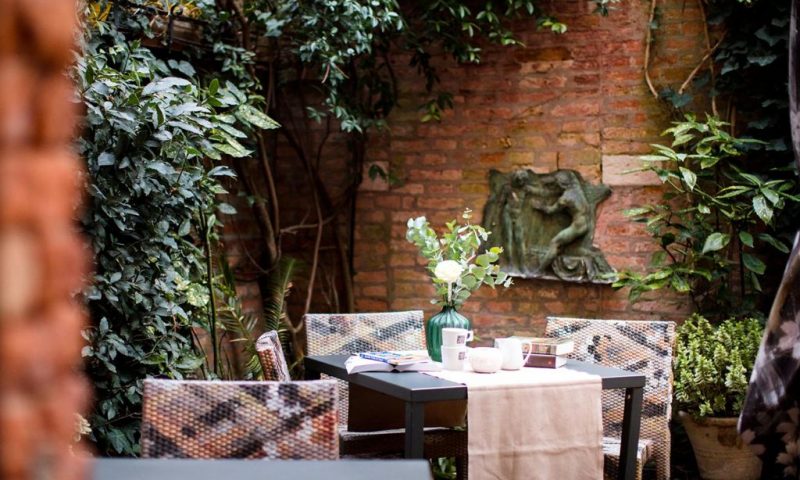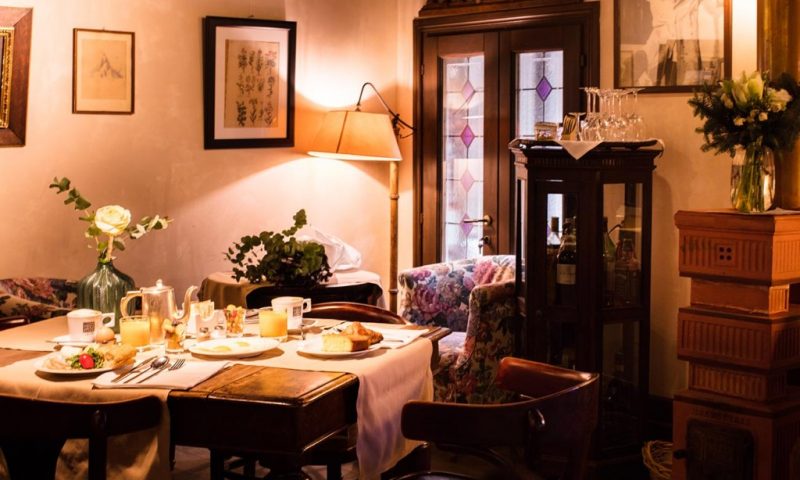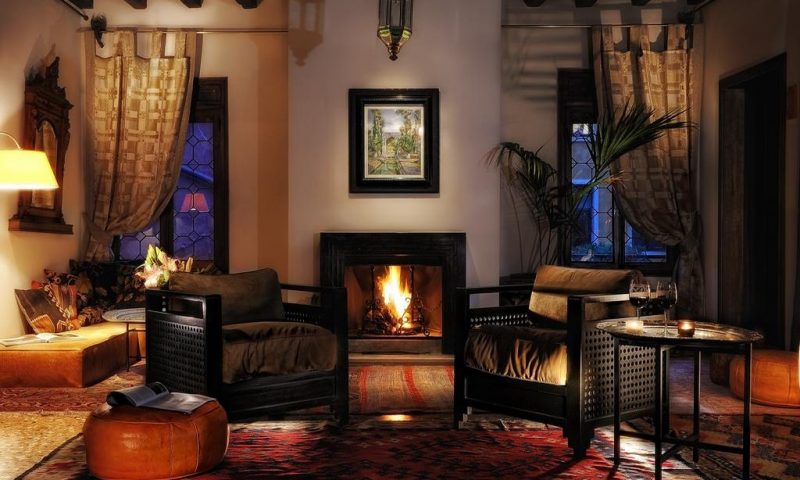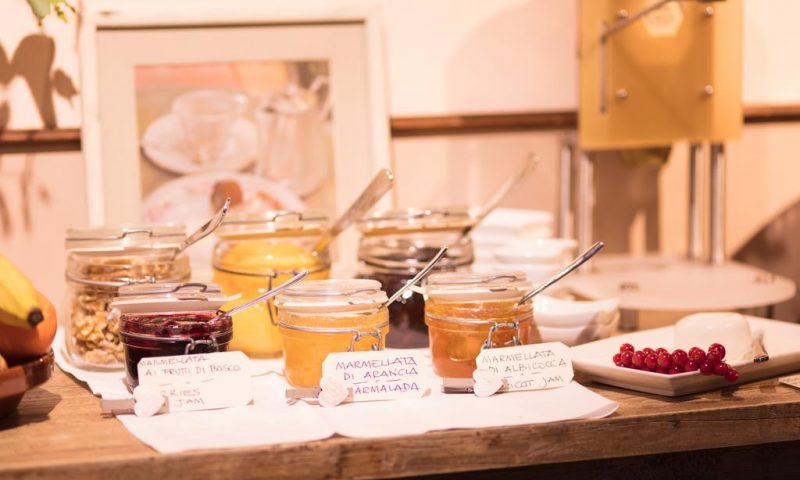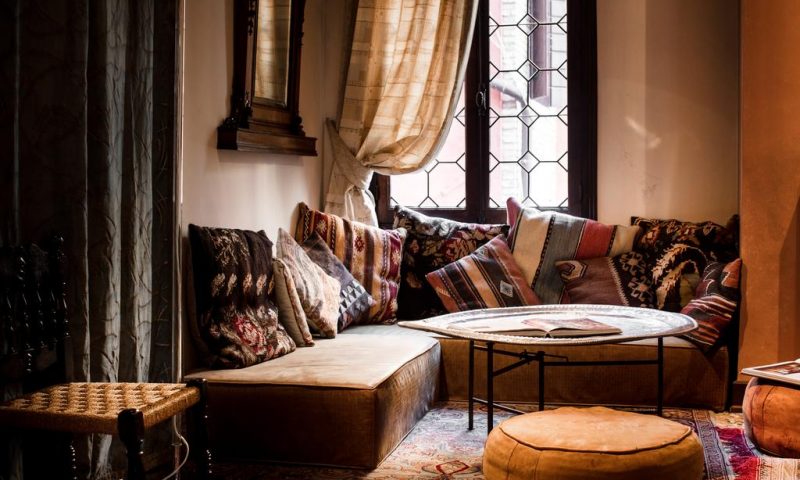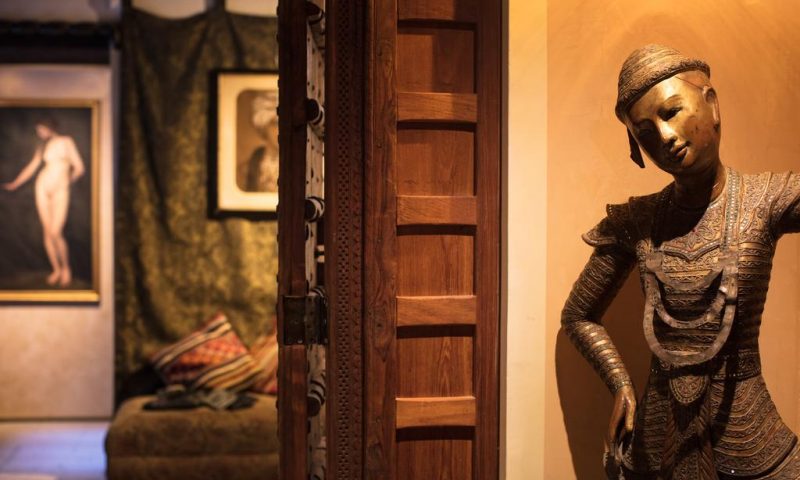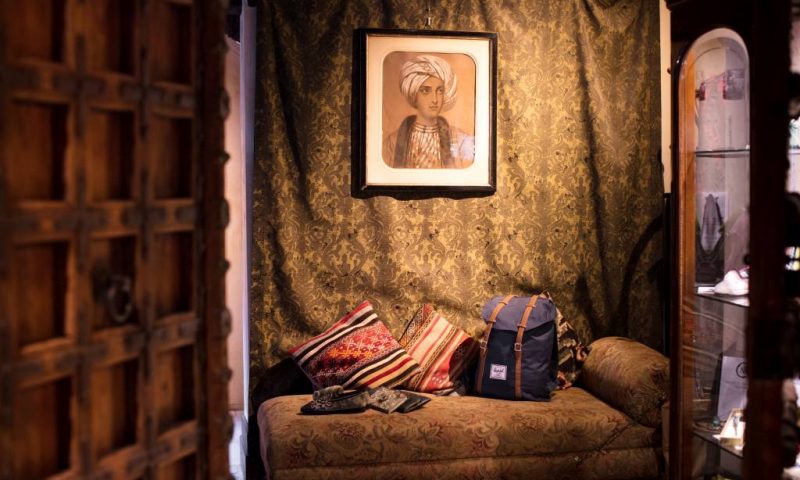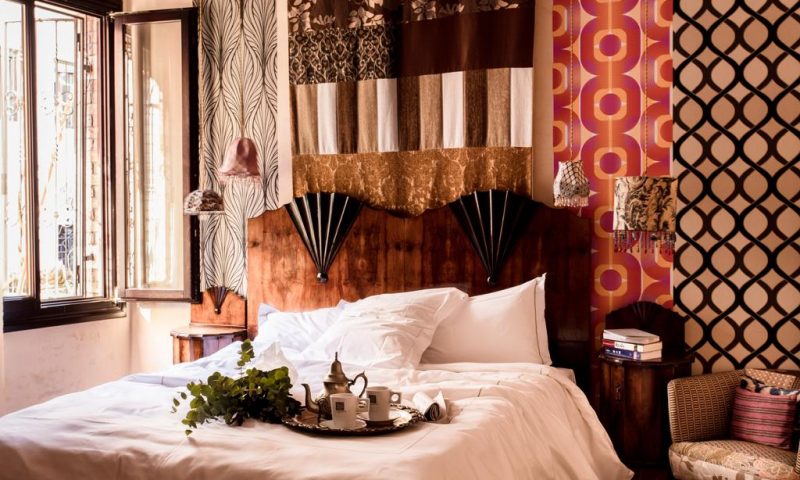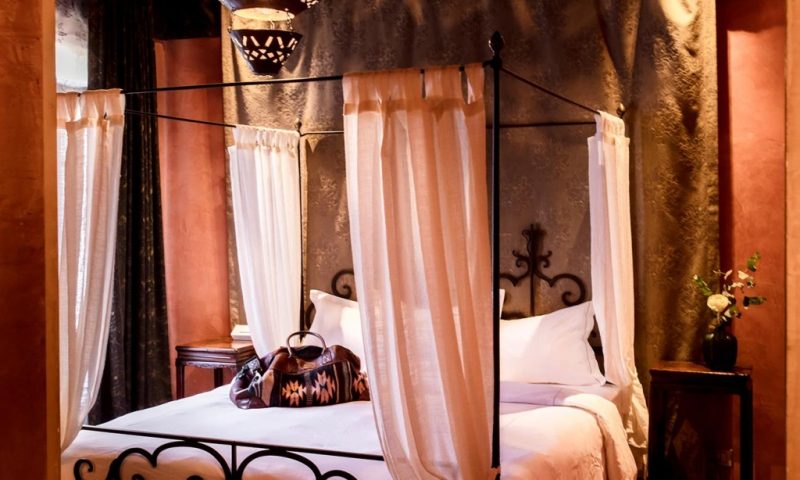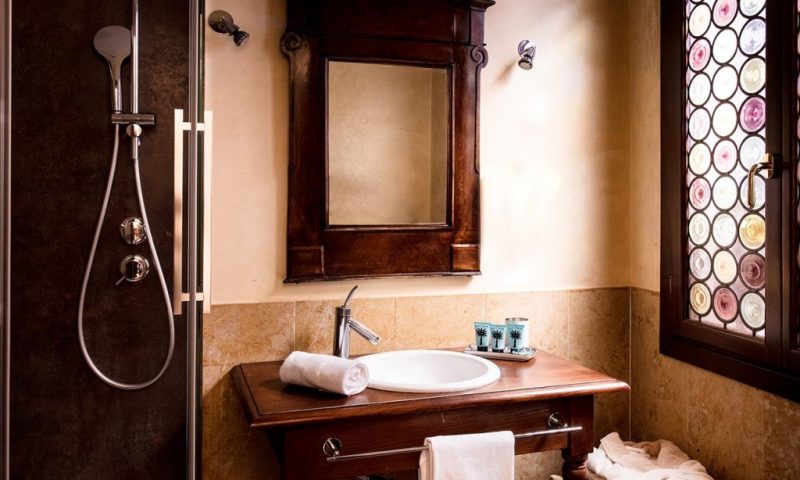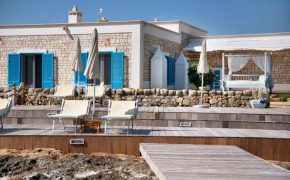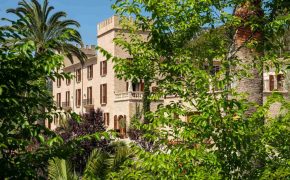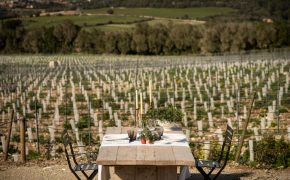The stylish Novecento Boutique Hotel Venice is tucked away in Calle del Dose, off Campo San Maurizio, between St. Mark’s Square and the Accademia Gallery. The Novecento offers its guests the chance to stay enveloped in an evocative atmosphere, created by a décor steeped in Orientalism and a passion for exquisite materials and fabrics.
The original furniture and tapestries from both the Mediterranean world and the Far East give the nine rooms an exclusive and refined character. The rooms blend the allure of an elegant exoticism with the most up-to- date facilities. Owned by the charming and enthusiastic Romanelli family, it’s become a haven for those seeking the ever-so-slightly bohemian side of Venice.
THE HISTORY
The Romanelli family has worked in hotellerie for over half a century. Alessandro Romanelli with Giuseppe Ungaretti, Hotel Flora. 1966. Alessandro Romanelli with Giuseppe Ungaretti, Hotel Flora. 1966.
The Romanelli family has been running the Hotel Flora for more than 50 years. The family mastered the hospitality craft since the 60s when Diana and Alessandro, together with their son Ruggero started this adventure.
In 2002, Gioele, Ruggero’s son, together with his wife Heiby realized that contemporary hotels should provide an experience more than just a “beautiful bedroom with restroom”. With this in mind, they opened the Novecento, a small nine-bedroom hotel, ethnic-chic in style that offered to its visitors a more authentic and contemporary experience.
The wish to give their guests a special welcome and provide them with impeccable service has led to the creation of INSIDE VENICE, an on-line guide to Venice produced by real Venetians.
It contains suggestions for alternative itineraries to discover the real Venice, which still exists but has become increasingly difficult to find. These successful experiments led the family with the support of Zoe, Gioele’s sister, to explore a new concept of hospitality, one where visitors become an integral part of a living city.
Was the ultimate and fundamental step to create. In 2017 Casa Flora finally opens its door: a large house in the heart of Venice, a space that is open, unique, to inhabit, work and socialize in, a home to experience the most beautiful city in the world feeling Venetian for a few days.
Casa Flora is an Italian-design apartment, completely custom made that welcomes travelers with the comforts of a boutique hotel but at the same time, the freedom of a private home.
ROOMS & SUITES
They present a mix of twentieth century multi-ethnic furniture or design created by Italian artists and stylists. A mixture of multi-ethnic furniture circa 1900, or designed by italian artists and stylists. Thai platform bed, a printed wall-hanging and a dark wood wardrobe.
Walls are rag-rolled or silk-hung, cotton drapes and curtains have been made up by a local factory to the Romanelli family’s own designs, and floors are original Venetian marble or wood with carpets collected from travels in Morocco. Some rooms have romantic four-poster beds, while others can be made up as twins.
Ensuites come in the form of compact shower bathrooms where you get Philippe Starck-designed fittings, big-headed showers, hairdryers and divine Ortigia toiletries. There’s also the option of soothing piped music from a selection that includes jazz, Arabian, classical and opera.
LIVING ROOM
Go oriental in the city of theatre, mirrors and illusion…The cosy living room has an honesty bar where guests can help themselves to a drink at any time of day, reading a book from our library, playing table games or simply relax listening our music.
BREAKFAST
Our sweet and savoury breakfast offers natural and simple homemade products. We do not know if a recipe for happiness really exists, but we are sure that our breakfast with home- made products, served in the fantastic and secluded internal courtyard, in the warm winter sun or in the refreshing shade in summer, is maybe the best way to start your day in Venice.
Our homemade cakes and pies are served with typical Italian coffee products, whose tradition suggests the use of fresh milk and top quality toasted coffee beans. What else do you need to be happy?
HONESTY BAR
Like in a private living room, our reading room will welcome you for a relaxing break at any moment of the day. We would like to make you feel at home, so you will always find a sweet corner of homemade pastries and biscuits and a hot drink for your afternoon break, a nice glass of wine for the evening or some liquor in our Honesty Bar. Newspapers, books and international magazines are at our guests’ disposal.
EVENTS
In the last few years, we have opened the doors of our rooms to art exhibitions, presentations, installations and events. We love to see them as an enlivened, happy place, where events happen, people feel good and have fun. If you want them to be your space for a day, please feel free to contact us, we will be happy to accommodate you.
INFLUENCED BY MARIANO FORTUNY
Influenced by the style of the early 1900s, it is no coincidence that the hotel draws its main inspiration from Mariano Fortuny, painter, fashion designer, scenographer and known for his ability to experiment in all areas of art. He moved to Venice in 1889 and made the historic Palazzo Pesaro-Orfei his home. From here Fortuny style spread throughout Europe.
Mariano Fortuny created some of the most remarkable fabrics and dresses of this century. His pleated silk gowns and velvet cloaks are regarded by collectors and museums around the world as the unique expression and embodiment of a craft at its best. However, he was not a couturier in the usual sense.
A painter by training, he adapted the line of his dresses to the natural shape of a woman’s body and sought to develop a type of garment that would not be subject to the whims of fashion. He was vigorously opposed to the restrictive and unnatural fashions of his time and remained aloof from the commercial world which produced them.
However, although he is known today primarily as a dress and fabric designer, Fortuny was also a painter, etcher, sculptor, photographer, lighting engineer, set designer, theater director, inventor and architect. Mariano Fortuny y Madrazo was born in Granada, the ancient Moorish capital of Spain, in 1871, of a family of Spanish artists.
As he grew, he was surrounded by a profusion of treasures that his parents collected: rare pieces of Hispano-Moresque pottery, Persian carpets, Islamic metalwork and armory, along with a rich collection of traditional fabrics and textiles.
Like everything associated with his father, who died when Mariano was three, this world held a special fascination for Fortuny: as a boy he had amused himself by dyeing pieces of material different colors.
His own textiles were imbued with the same antique quality possessed by the fabrics, mellowed with age, that had surrounded him as a child. The designs on the velvets, brocades, silks and chasubles in his parents’ collection were imprinted upon his imagination many years before he started his own production.
After the elder Fortuny’s death, his mother moved the family to Paris, where she organized a small salon for the friends and followers of her late husband, and also encouraged Mariano to start painting.
Along with painting, he learned etching at an early age. In 1889, his mother moved again, this time to Venice. The start of Fortuny’s most creative period coincided with his move to the Palazzo Pesaro Orfei in 1899.
It was a magnificent palace built in the thirteenth century and became an ideal work place, a building full of large, open spaces in which he could give full rein to his various talents. It eventually became the Palazzo Fortuny, the house of the magician.
The elements which came to have the greatest influences on Fortuny were the art of the past and that of non-Western cultures where the concept of progress and change did not exist until the arrival of European colonists.
His favorite periods were Classical Greece, the Renaissance and the great Venetian art of the fifteenth and sixteenth centuries, which still surrounded him. Of all non-Western cultures, the one he preferred was the Arabic, during the era of its greatest expansion when it extended from Morocco to India, passing through Persia and the Near East.
One of Fortuny’s main sources of inspiration was Richard Wagner. The legends that provided the basis for Wagner’s musical dramas also furnished Fortuny with a vast range of images, which he developed in his paintings and engravings.
Wagner and ‘Wagnerianism’ were essential elements of the fin-de-siecle, and as a young man, Fortuny was introduced to Wagnerian music and mythology. His Wagnerian experience was a decisive milestone in his career, introducing him to new aesthetic possiblities.
He went on to do much work in the theater, specifically related to lighting and set design. This theater work lead him, during the course of research, to his first serious contact with the art of costume. He designed the costumes for several theatrical productions, but his first purely fashion garment was the Knossos scarf.
The scarf was made of silk and was rectangular in shape, printed with geometric, asymmetrical patterns and motifs inspired by Cycladic art. The scarves could be used in a number of ways, allowing great freedom of expression and movement to the human body.
It was from these simple scarves, which showed him how to fuse form and fabric, that Fortuny developed his entire production of dresses. All the dresses were produced in his studio.
They were made by hand, individually, as were all the materials that went into them: the pleated and printed silk, the velvets, the cords that were used to gather them or unite the different parts, the linings which were of satin , silk, wool, the belts, the labels.
Everything was made on the premises, including accessories as the dresses had no pockets, their wearers needed bags, which Fortuny made from his own multi-colored velvet in very simple designs.
Parisian high society was aware of Fortuny’s creations and longed to possess them. These influential women of the beau monde, whose lives Proust was to describe in such minute detail, made him aware of Fortuny.
On at least sixteen occasionsthroughout Remembrance of Things Past there are references to Fortuny or to his dresses. In the volume entitled The Captive, Fortuny constitutes a whole leitmotiv and is the only character in the whole of Proust’s long work who retains a real-life name and identity. The descriptions, comments and associations go far beyond the needs of literature, reflecting a very real knowledge of and fascination for his dresses. (Luca Colferai)
